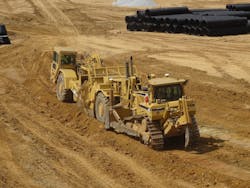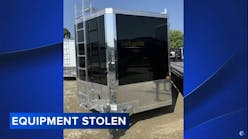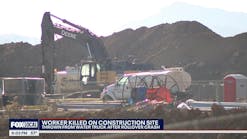Reprinted with the permission of Equipment Manager magazine, the magazine of the Association of Equipment Management Professionals.
Don Swasing, CEM, STSC, has been in the industry for 39 years and today is CEO at Schlouch, Inc. His experience and training have been extensive, but the incident that changed his perspective on safety happened on a job site.
“I almost got run over by a loaded articulated dump truck,” he says. “Almost getting hit by a truck that day was the first time I truly realized what a near miss was.”
As a result of that experience, Swasing says, “We implemented a work rule, and we all fell in line. Nobody should be inside the path of production traffic. There is some complacency that builds over time in our industry.”
Near misses happen across the industry every day, but Swasing and Schlouch’s safety team have had such positive results, that “a paradigm shift has occurred here.”
He explains: “We define a near miss as an unplanned event that has the potential for danger, injury, or death.”
The communication of the near miss is important, he says, so that the hazards of the safety issue that is identified “get cascaded through the rest of your company. Many other employees may be exposed to the same hazard.”
A recent near miss occurred when a work crew was assembling three 2x4 concrete-cast inlet boxes. A step on the ladder incorporated inside the box pulled out of the concrete.
“The worker could have fallen into the box and broken his neck,” Swasing says, “not to mention how many of those steps had already been put into the ground. We put a hundred of those boxes in over the course of a year.”
The near accident was reported to the office and communicated to the field and others in the company who were exposed to the same hazards. Swasing then contacted the manufacturer “and demanded that the problem be corrected. I wanted to hear what happened... and how the manufacturer corrected it.”
Although there is no formal document for reporting near misses, Swasing says Schlouch conducts an investigation and, when complete, details are sent by email—depending on the severity of the near miss, especially if the incident is bad enough to expose the whole department to the hazard. Job site safety analyses are done on a regular basis.
“We do a good job here, but you’re not going to get them all,” says Steve Funk, STSC, General Superintendent.
Some are reluctant to report near misses, maybe due to an embarrassment factor involved about admitting that something was wrong or somebody wasn’t paying attention. Schlouch has found one of the ways around the reluctance is not to have any repercussions for reporting near misses.
“There is no write-up or anything,” says Kevin Reimert, CEM, STSC, Equipment Coordinator. “We try to take away any consequence. The idea behind tracking near misses is really about keeping employees safe.”
To establish and implement a successful process for reporting a near miss requires that the field trust management leadership.
“That’s where the magic comes in—by acknowledging their fear and by trying to reduce or eliminate it through training,” Swasing says. “If the guys shout out something, and it continues to happen, the company has an obligation to do a lot better training in that area.”
Otherwise, a document might be produced, but no real results will be associated with it. The company has to have effective leadership that is supportive of creating a safer environment. If you don’t have that, Swasing says, a near miss document won’t limit the incidents.
“It won’t go anywhere,” he says. “It’s just a policy.”
Ed Gestido, CEM, has worked for Gray & Son/Maryland Paving for 14 years. He was recently promoted from Equipment Manager to Director of Asset Management. Gray & Son/Maryland Paving follows OSHA recommendations to record near misses—“which they do,” he says—although OSHA does not lay down any guidelines to follow.
In his new position, Gestido doesn’t spend as much time on the shop floor, as Gray & Son/Maryland Paving had hired an equipment manager to take over his former responsibilities. However, he still receives near-miss information and incident reports weekly, and during a weekly scheduling meeting including all divisions of the company, the group “discusses everything from structural repairs to near misses and what’s going on in the shop. That keeps me updated,” Gestido says.
The company looks at a near miss as “an unplanned event that did not result in an injury or illness,” which is the definition given by the National Safety Council. A near miss, however, has all the elements of an accident.
“The outcome itself can be either positive or negative,” he says. “You install a culture that raises everyone’s awareness. When you have a near miss, the positive approach is to identify what could have negatively impacted the situation.”
He gave this hypothetical example: An off-road truck is backing up to a certain point. Everyone is in a hurry, but the operator really doesn’t have a good view of where he is. He’s looking back but, for whatever reason, doesn’t see the people working behind him. The operator should know that when he has no clear line of vision he should use a spotter, but he goes ahead and backs up anyway. Finally, someone yells at him, and he stops and no one is hurt.
“But if he had run over someone, there is no going back,” Gestido says.
Employees reporting a near miss would contact Gray & Son/Maryland Paving’s safety department, led by Safety Manager Lenny Corbin. The department documents the incident and reports it to management—if the near miss had the potential for a real disaster. The safety department, in turn, would report the information to the workforce through a safety toolbox talk, says Gestido.
“Of course, if the situation posed an imminent danger, work halts immediately and a discussion would occur right then and there with the crew and foreman led by the Safety Team,” he says.
To encourage workers to report near misses, every report is anonymous. Normally, only the job site where the incident occurred would know who was involved, Gestido says. If the incident happened at a job site where individuals frequently come across the job task, the safety department would go out and discuss the situation with the work foreman and everyone on the crew.
“That’s how we approach it,” says Gestido. “As a matter of fact, we don’t even identify specific units or individuals who were involved. We report just the facts in order to eliminate rumors.”
Unfortunately, he says, near misses happen every day but many times go unnoticed. When any near miss is reported, however, no disciplinary action is taken.
“We try and present it positively, but yet make everyone aware at the same time of the potential of it being an accident of some kind,” Gestido says.
In addition to the toolbox talks and other safety steps, Gray & Son has a “Foremen’s Huddle” made up of 54 foremen who meet every month, says Gestido.
“We talk about everything, including what’s happening in the company and share the information,” he says. “We believe the more we share information the better it is for everyone to understand the roles they play and what we need to do going forward.
“When we identify a near miss, such as the truck backing up, we put a money value on it. For instance, if the vehicle backs up and hits a curb, blowing a tire, that costs us $6,200 for a tire. Everyone understands how that has an impact on the bottom line, especially when you consider that we have 300 on-road and 250 off-road vehicles. And that’s not counting all the miscellaneous odds and ends that we have between Gray & Son, the construction side of the business, and Maryland Paving, our manufacturing side, which consists of seven asphalt plants,” he says.
Carl M. Uhinck, CEM, Asphalt Equipment Manager for Kokosing Construction Co., has a different approach.
“I never, ever define an incident as a near miss,” he says. “I define it as a near hit. There is no such thing as a near miss. You are studying things that are a near hit.”
He also has a different view in defining the goal of tracking near hits.
“People say, let’s go for zero injuries. I always want to get my people and myself at zero at-risk behavior. For that you need to have information. You can get to zero injuries by accident.”
The quality of reporting near hits provides information used to improve processes and, probably more so, at-risk behavior, he says. “That’s where it is for me.”
Kokosing has a formal process for reporting near hits.
“Your expectations are to report all near hits immediately to your supervisor, whoever that may be,” Uhinck says. All near hits go to a central location. “Not only does the group or division learn from it, but the whole company at this point can be informed.
“There are several kinds of near hits,” he says. “Some could [have the potential to be] fatal. That is a different investigation process as opposed to nearly slipping on the ice.”
Among the hundreds of near hits that are reported each year, slipping on the ice is a common one. Such a report might say, “I chose to use the entryway on the east side of the building before it was salted.” In that case, Uhinck says, the worker didn’t fall, but he almost did.
“If the worker had fallen and landed on the ice but was uninjured and took some sort of action to get rid of the patch of ice, that is still a near hit.”
Those types of investigation take Uhinck three or four minutes, he says. The information goes to central, where it is collected on the day the incident happens and used in safety talks, which are conducted every day before work starts.
“We make sure everybody understands what we did and tell them to use caution. We remind them that we have tools they can use—boot grips to get better traction, for instance. That’s a normal type of near-hit report,” Uhinck says.
A more serious situation requires a much different investigation process. For example, an operator may park a piece of equipment and exit the machine. The machine rolls forward and hits another piece of equipment, but no one is injured. In addition to the usual near-hit investigation, general liabilities procedures are set in motion because the machines were damaged.
“Now I have the potential for the operator or laborer or one of my mechanics to be pinned in between and crushed between the machines,” Uhinck says.
After following the same type of report, he talks to everyone who needs to be part of the investigation: people who would be running the equipment, the project superintendent, the equipment manager, the project manager and perhaps a mechanic, “because I would want to know if the braking and hydraulic system was functional or if hydraulics were used.”
Uhinck and the project team would investigate the position of the machine. Which way was it facing? Where was the machine parked? Which side was it parked on? Did the machine roll when the operator was not in place and why? At the end of that, he says, “A change in process is made because ultimately there are no near hits where you can’t do something to improve at-risk behavior.”
Uhinck says people must have the courage to speak up if a near hit occurs. “It’s all about culture,” he says. “We at Kokosing have a strong safety culture. My people know that I want them to be safe for themselves, for their families and for their co-workers. That’s why I want to know what happened and why. I collect the information to make the job a safer place to work.”
That information is distributed throughout the company and “where it applies to you, you share that with your people to learn through the experience of others.”
Ultimately, he says, “We want people to be safe without having to experience the other end of it. We want people not to touch a hot stove.”





